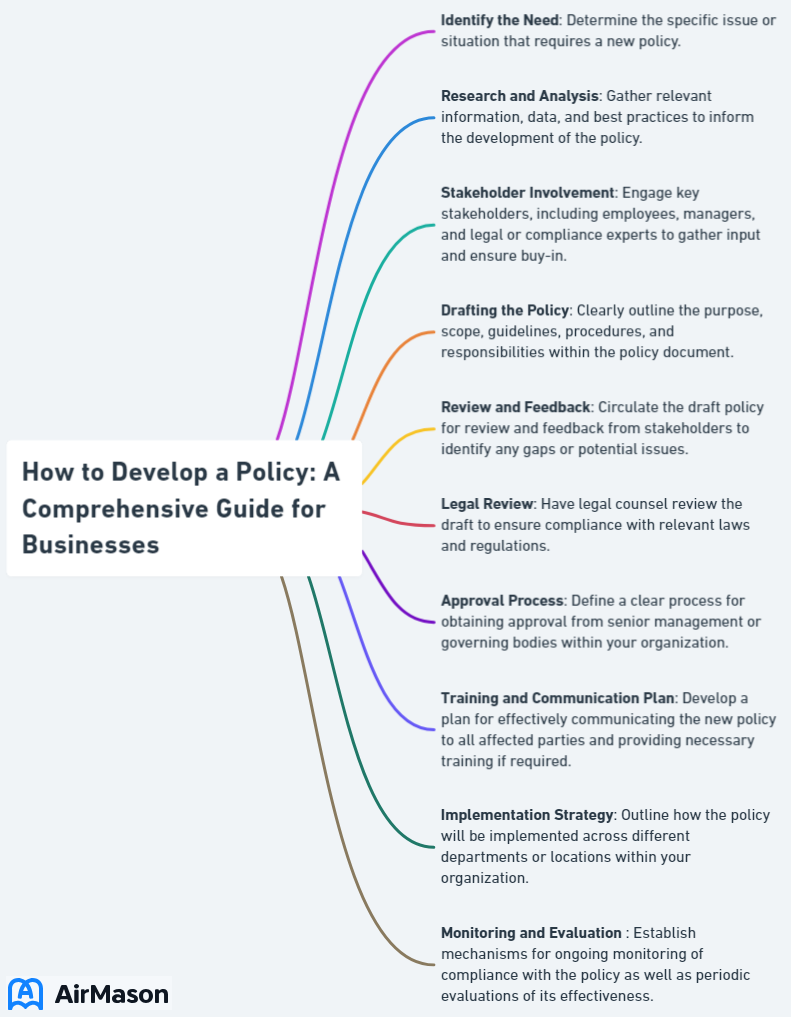
Are you aware of the importance of policies in business operations and their role in ensuring legal and regulatory compliance? In this comprehensive guide, we’ll dive deep into the process of how to develop a policy, implementation, and enforcement, providing you with valuable insights and actionable steps to create and maintain well-written policies for your organization.
Key Takeaways
- Understanding the need for policies and their role in business operations is essential to ensure organizational efficiency, law & regulation compliance, and strategic decision-making.
- The process of developing a policy involves determining focus, research & feedback from stakeholders, drafting the policy & revising it for accuracy/completeness.
- To successfully develop policies businesses must address resistance to change. Balance flexibility/consistency. Exploit legal/regulatory guidelines. Utilize appropriate software features such as review workflows and integration with regulatory bodies.
Understanding the Need for Policies
Policies are indispensable for businesses to guarantee effective operations and adherence to legal and regulatory guidelines. They delineate the expected behavior of employees and outline the responsibilities of both management and employees, ensuring compliance with relevant laws.
Writing policies aids organizations in establishing law and regulation compliance, providing a strategic outlook for decision-making, and streamlining processes through policy creation. Conducting a policy review ensures that these policies remain effective and up-to-date. In this context, policy writing plays a crucial role in maintaining organizational efficiency.
The Role of Policies in Business Operations
Formulating policies delineates the ethos of an organization by guiding decisions and furnishing a structure for regular operations, which is why it is important to write policies effectively. A well-crafted policy document should:
- Be lucid and comprehensible
- Be arranged in an orderly fashion
- Be uniform
- Include pertinent visuals
- Be readily available
- Comply with the organization’s branding regulations
A regular monitor of policy compliance allows for:
- the detection of any deviations or potential issues related to employee behavior
- the evaluation of policy efficacy
- contributing to smooth business operations.

Legal and Regulatory Compliance
Legal and regulatory compliance is imperative for businesses in order to avert penalties, sustain a positive reputation, and guarantee seamless operations. To secure compliance, the following aspects of policy compliance management are indispensable:
- Setting up employee education
- Observation and assessment
- Implementation of penalties and rewards
- Ongoing refinement
Establishing regular monitoring and auditing to evaluate compliance levels, taking into account industry trends and best practices, is crucial for maintaining legal and regulatory compliance. Keep in mind that regular modifications to your own policies or compliance management techniques should be implemented to enhance efficiency based on observation and feedback.
Steps to Develop a Policy
Developing a policy involves several key steps, including determining the focus of the document, conducting research on the relevant background information, and seeking feedback from relevant stakeholders. Conducting internal research facilitates understanding of your organization’s mission, values, and objectives, allows for the examination of existing policies to prevent replication or inconsistencies, and aids in the analysis of relevant data, statistics, and previous occurrences.
The subsequent step in policy development is to draft the policy, seek feedback, and revise it accordingly to ensure accuracy and completeness.
Conduct Thorough Research
Optimal practices for conducting research for policy development involve:
- Facilitating a broad spectrum of stakeholders through co-designing the research
- Prioritizing research that is pertinent to policy
- Encouraging the utilization of evidence in policy and decision-making
- Examining research literature
Undertaking exhaustive research facilitates the identification of optimal procedures, the collection of input from relevant parties, and the assurance of harmony with corporate objectives.
As a policy owner, you are responsible for:
- Formulating new or updated policies
- Undertaking extensive research
- Acquiring pertinent information
- Including relevant stakeholders
- Ensuring that policies are complete and aligned with the organization’s objectives.
Consult Relevant Parties
Incorporating pertinent stakeholders from the initial phases of policy formation guarantees their consent and collaboration. In policy development, you should consult:
- Community members
- Participants
- Investigators
- Researchers
- Advisory board members
- Banks
- Civil society organizations
- Development organizations
Involving employees in policy development can greatly enhance its effectiveness, as it facilitates better communication, transparency, and performance, thus leading to increased employee engagement and organizational effectiveness. Management plays a crucial role in formulating, communicating, executing, and sustaining policies within an organization, and is accountable for guaranteeing that policies are formulated in accordance with the organization’s objectives and goals.
Drafting and Reviewing the Policy
It is recommended to conduct a thorough review, solicit feedback from various departments and levels of the organization, revise the policy in accordance with the feedback, and guarantee that it is consistent with the organization’s language and style when drafting and revising a policy. Obtaining feedback from knowledgeable persons and appropriate stakeholders guarantees the accuracy and completeness of the policy.
When constructing a policy, it is advisable to avoid using ambiguous language and jargon to ensure that the policy is easily understood by all employees. Entrusting someone other than the policy owner to compose the initial draft may assist in providing an external outlook, ultimately rendering the procedures more applicable to everyday operations.
Key Components of a Well-Written Policy

A well-crafted policy comprises several essential elements, including a policy statement, scope and applicability, and responsibilities and procedures. To write a policy, you should select a clear and descriptive title that reflects the policy’s purpose, include a policy brief statement that explicitly states the purpose and objectives of the policy, and present the policy in a logical and organized manner.
Policy Statement
The policy statement serves to elucidate the purpose and intent of the policy. The significance of clarity in a policy statement is to ensure uniformity in decision-making through the provision of explicit guidelines and regulations, eliminating any vagueness and perplexity, enabling personnel to comprehend and act in accordance with the organization’s stance.
When constructing a policy statement, it is suggested to:
- Identify the key policy details
- Supply the necessary background information
- Describe the process
- Provide an alternative
- Ensure the policy is compatible with the organization’s culture and tone.
Scope and Applicability
In a policy context, scope denotes the limits and extent of the policy, while applicability alludes to the particular situations or entities to which the policy applies. To define the scope of a policy, you must clearly articulate its purpose and boundaries, including outlining the specific application or area to which the policy applies and the desired outcomes.
In order to determine the applicability of a policy, you should consider the following:
- The purpose and scope of the policy
- The specific areas or departments to which the policy applies
- Collaborate with internal stakeholders to ensure their input and understanding of the policy.
Responsibilities and Procedures
Responsibilities in policy adherence guarantee that policies are being followed and complied with. Procedures facilitate the implementation of company policies by supplying a logical and structured methodology for employees to adhere to, acting as guides that delineate the precise steps and activities essential to comply with the policies.
In order to identify those responsible for implementing a policy, you need to:
- Comprehend the objectives of the policy
- Recognize the individuals or departments involved
- Ascertain the necessary inputs and resources
- Record the responsibilities and roles of each person or department
By following these steps, you can effectively identify the responsible parties for policy implementation.
Implementing and Enforcing the Policy

The steps for implementing policies involve:
- Conducting comprehensive research
- Consulting pertinent stakeholders
- Formulating and scrutinizing the policy
- Implementing the policy
The implementation and enforcement of policies within the entire organization is essential to guarantee compliance and avert penalties, as well as to continually enhance operations.
Communication and Training
Policy owners are tasked with effective policy communication to all relevant parties, which ensures employees understand the policies, their purpose, and implications. Clear communication aids in reducing potential misunderstandings and guarantees consistent adherence across the organization.
Employers have a responsibility to equip employees with the necessary training and educational guidance for successful execution. Providing such human resources enables employees to meet this aim effectively.
Monitoring and Evaluation
Monitoring and evaluation are important to pinpoint areas of opportunity and guarantee the policy remains pertinent and effective. Policy owners must establish systems for monitoring compliance and perform regular reviews to evaluate the efficacy of policies.
Conducting regular policy evaluations can help to ensure relevance, effectiveness, efficiency, and accountability in the implementation of policy.
Continuous Improvement
Continuous improvement involves regularly reviewing and updating the policy in order to ensure its adaptability to changing circumstances and its continued effectiveness. The frequency of review and revision is contingent upon the policy, with some requiring review every six months and others requiring review once a year or every few years.
Monitoring and assessing business policies on a regular basis is vital for the following reasons:
- Ensuring effectiveness
- Adapting to changing conditions
- Identifying compliance issues
- Enhancing efficiency
- Fostering continuous improvement
Overcoming Challenges in Policy Development

Challenges in policy development can include resistance to change, the necessity to maintain a balance between flexibility and consistency, and the need to guarantee compliance with legal and regulatory guidelines. To overcome these challenges, businesses must address resistance to change through transparent communication and employee involvement, balance flexibility and consistency by setting clear expectations and furnishing guidance on how to manage exceptions, and exploit policy management software to streamline the policy formation process and guarantee compliance.
Resistance to Change

Frequent causes of resistance to changes in company policies among employees may include:
- Mistrust and lack of confidence
- Emotional reactions
- Lack of training and resources
- Fear of failure
- Inadequate communication
- Potential loss of status or job security
- Protecting co-workers
- Unwillingness to acquire new knowledge
- Lack of knowledge or expertise
- Insufficient compensation
Resistance to change can be effectively addressed through transparent communication, incorporating employee input, and illustrating the advantages of the policy.
Balancing Flexibility and Consistency
Finding a middle ground between having set guidelines and allowing for adaptability is what is meant by balancing flexibility and consistency in policy development. This entails creating policies that provide a framework for decision-making and actions, while concurrently enabling alterations based on varying conditions or unforeseen events.
This equilibrium guarantees that policies are efficacious and applicable while still being able to accommodate various circumstances.
Ensuring Compliance with Legal and Regulatory Guidelines
Compliance with legal or regulatory guidelines is crucial for businesses to avoid penalties and maintain a positive reputation. To ensure compliance, businesses should:
- Gain knowledge of the pertinent laws and regulations
- Include legal and compliance professionals
- Execute a compliance evaluation
- Incorporate legal and regulatory requirements into policies
- Periodically review and revise policies.
Utilizing Policy Management Software

Utilizing policy management software can streamline the policy development process, providing features and advantages such as templates, automated distribution, and straightforward revision control. This software can facilitate the policy development process by providing a centralized repository for storing and managing policies, automating the review and approval procedures, interfacing with CRM systems, analyzing the existing systems and processes, and providing user-friendly interfaces.
Features and Benefits
The advantages of policy management software include enhanced efficiency, collaboration, and adherence to regulations. Primary characteristics of top-rated policy management software include creation and editing of policies, review and approval workflows, integration with regulatory bodies, policy visibility and tracking, reduction in workload, and a user-friendly interface.
Policy management software augments efficiency in an organization by means of time-saving automation, a centralized policy library, version control and tracking, and personalized policy delivery.
Selecting the Right Software
Selecting the right policy management software requires consideration of factors such as ease of use, scalability, and integration with existing systems. Scalability ensures that the software can proficiently manage and sustain policies as the organization grows and develops, decreasing maintenance costs and enhancing the user experience.
Policy management software integrates with existing systems by providing:
- A centralized repository for storing and managing policies
- Automating the review and approval procedures
- Interfacing with CRM systems
- Analyzing the existing systems and processes
- Enforcing permissions.
Summary
In conclusion, developing, implementing, and enforcing effective policies in your organization is a critical aspect of ensuring smooth operations and compliance with legal and regulatory guidelines. By following the steps and strategies outlined in this comprehensive guide, you can create well-written policies that support your business objectives and maintain a positive reputation. Remember, continuous improvement and adaptation to changing circumstances are key to the ongoing success of your organization’s policies.
Frequently Asked Questions
What are the 7 steps of creating a policy?
The seven steps for creating a policy are issue identification and definition, data, research, and analysis for policymaking, policy formulation, consultation, policy adoption, implementation, and monitoring and evaluation.
What is the purpose of developing a policy?
The purpose of developing a policy is to ensure that an organization’s mission, vision, values, and culture are accessible and clearly understood by all employees. It serves as a tangible guide for behavior and decisions.
How do you develop and implement a policy?
Developing and implementing a policy requires identifying the need, determining content, obtaining stakeholder support, communicating with employees, updating and revising the policy, performing research, starting a test implementation, gaining management support, performing legal checks, communicating the policy, giving a date of implementation, and holding informational meetings.
What is the format for writing a policy?
Policy writing should begin with a clear policy statement, followed by definitions of any specific terms and concepts used. Content should be presented in a logical and organized manner, using a formal tone and avoiding unnecessary introductions or summaries.
What is the difference between a policy and a procedure?
Policies are broad guidelines that set the standards for an organization, while procedures provide the specific steps and instructions to follow those policies.